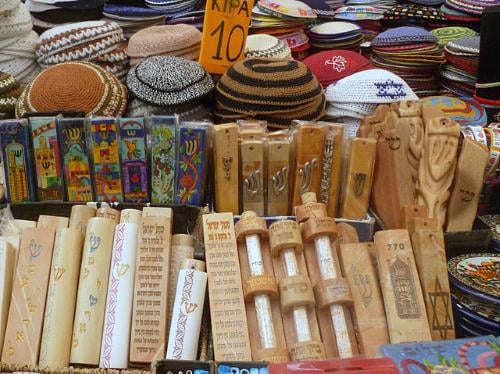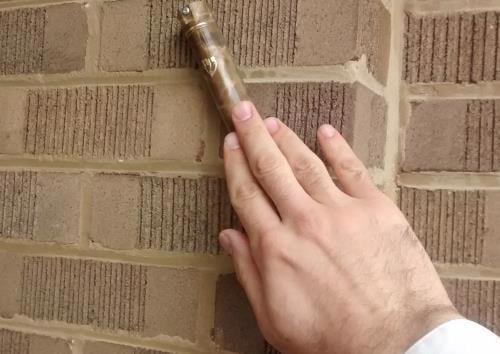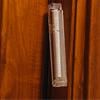Mezuzah (Hebrew: מזוזה) literally means “doorpost,” and it refers to a small parchment scroll upon which the Hebrew words of the Shema are handwritten by a scribe. Mezuzah scrolls are rolled up and affixed to the doorposts of Jewish homes.
Mezuzah In Jewish Tradition
The mezuzah is the hallmark of the Jewish home, demonstrating that it leads to a Jewish household. When a Jewish family affixes a mezuzah on their permanent residence they are forming another link in Jewish history and continuing a tradition that goes back to Biblical times.
What Constitutes a Kosher Mezuzah?
The decorative case containing the mezuzah scroll is just that: a mere container. What’s important is the scroll, upon which the first two sections of the Shema (the "mezuzah prayer")are handwritten, beginning with the eternal words “Hear o Israel, the L‑rd is our G‑d, the L‑rd is One.”1 These selections both contain G‑d’s instruction to affix the mezuzah: “You shall write them on the doorposts of your house and on your gates.”

These words are handwritten by an expert scribe who is trained in the many laws involved in writing a mezuzah, including the requirement that it be written with special intention and that the words be written in order.
Every single letter in the mezuzah must be properly formed. A single crack in the parchment or any omission can invalidate the entire scroll. A printed mezuzah is invalid. For this reason it is vital that it be purchased from a reputable scribe or retailer, such as our online store.
On the reverse side of the scroll, the scribe writes one of G‑d’s names: Sha-dai. The three letters of this name form an acronym for the Hebrew words that mean “Guardian of the doorways of Israel.” Since this name of G‑d begins with the letter shin, mezuzah cases are often decorated with that letter.
More on how a mezuzah is written here.

Where Do Mezuzahs Hang?
You should hang a mezuzah on just about every doorway that belongs to you. Notable exceptions are doors leading to bathrooms and small closets.
The mezuzah should be hung on the right side of the door, on the top third of the doorway. The mezuzah should be right-side up, and slanted so that the top of the mezuzah faces inwards towards the room.
Read our one-page guide on mezuzah placement here.

What Is the Meaning of the Mezuzah and Why Do We Use It?
Hanging a mezuzah on our doors fulfills a Biblical command, but it also has a very important message and provides a unique service to the denizens of our homes.
The mezuzah means that Judaism is not confined to synagogues. We strive for spirituality even within the comfort and familiarity of our own homes. The mezuzah on the doorpost reminds those who walk through that G‑dly life and Torah accompany them wherever they go.
Our sages teach that a mezuzah has the unique property of protecting the inhabitants of the home where it is hung—whether the inhabitants are inside or outside that home. The mezuzah can be compared to a “helmet,” a veneer that protects us against the dangers that surround us in our lives.
The Talmud teaches that while most kings sit on the inside while their guards protect them from without, G‑d stations His protection (as manifested in the mezuzah) on the outside, protecting His beloved people.
G‑d promises that anyone who carefully observes the mitzvah of mezuzah will lead a longer, richer life, as will their descendants, as Deuteronomy states, “So that you will prolong your days and the days of your children.”2
Read more about the protective power of mezuzah here.
When passing through a doorway where a mezuzah has been affixed, we glance at it and touch it. Some people then kiss their fingertips. This serves as a reminder throughout the day that G‑d is always with us, inside or outside our homes.
Read about why we kiss the mezuzah here.

The Prayer Said Before Affixing a Mezuzah
בָּרוּך אַתָּה אַדָנָ-י אֶלוֹהֵ-ינוּ מֶלֶך הָעוֹלָם אַשֶר קְדִשָנוּ בְּמִצְווֹתָיו וְצִיווָנוּ לִקְבּוֹעַ מְזוּזָה
Bah-rookh ah-tah ah-doh-noi eh-loh-hay-noo meh-lekh hah-oh-lahm ah-sher ki-deh-shah-noo beh-mitz-voh-tahv veh-tzee-vah-noo lik-boh-ah meh-zoo-zah.
Blessed are you, L-rd our G‑d, King of the Universe, Who has made us holy with His commandments and commanded us to affix a mezuzah.
How to Check the Mezuzah
It is customary to have mezuzahs checked twice every seven years, or even every year, prior to the High Holidays. Even if the mezuzah was purchased from a reputable source and previously found to be perfectly kosher, there is always room for human error, and new cracks and other problems can appear with time. Of course, this checking must be done by an expert scribe.
The Lubavitcher Rebbe, Rabbi Menachem M. Schneerson, of righteous memory, would often urge people who encountered health challenges or other difficulties to have their mezuzahs (and tefillin) checked to make sure that every scroll was in good shape and properly placed on the doorpost.
If you need help getting a new mezuzah or having your existing ones checked, closest Chabad rabbi will be happy to assist you, or you can get a mezuzah scroll or case from our online store.
Can We Make Our Own Mezuzah?
Yes and no. The mezuzah scroll, upon which is written the mezuzah prayer, must be made out of specialized materials by a highly competent scribe. However, the mezuzah case is something you can make on your own. Clay, PVC pipes, wood and many other craft materials are good for mezuzah cases. So get creative and have fun. Don’t forget that it’s traditional to put the Hebrew letter shin (ש) on the case, often near the top.







Join the Discussion